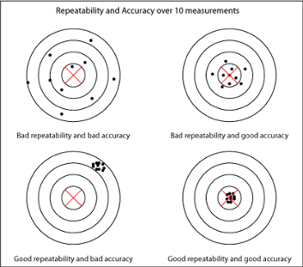Experiments Show Universal Robots' Repeatability

Posted on Jul 13, 2015 in Robots
2 min read time
There are a relatively large number of robotic applications that require approximate or rough accuracy. Packaging or pick-and-place are often precise to 0.5 mm. With the introduction of collaborative robots, detractors will claim that these robots aren't precise enough. However, if you are ready to accept that your collaborative robot will be less precise than an industrial one, well, choose a collaborative robot for its other features like safety. But, if we go back to the basis of this problem, what is accuracy? And what is the accuracy of collaborative robots?
 Often people will be mixed-up between accuracy and repeatability. In most robotic applications, repeatability is way more important than accuracy. In fact, you probably want to pick a part at the very same, exact spot you picked the previous one. Even if the absolute position of the robot has a 0.5 mm offset in each axis, if you can repeat this position, your object will be grasped the way it is meant to be. This statement is especially true for collaborative robots. In fact, since you are not asking for a cartesian position, but a point in space (that has been determined manually), you don't really care about accuracy, what you want is for the robot to repeat this position again and again, to do the exact same routine each and every time.
Often people will be mixed-up between accuracy and repeatability. In most robotic applications, repeatability is way more important than accuracy. In fact, you probably want to pick a part at the very same, exact spot you picked the previous one. Even if the absolute position of the robot has a 0.5 mm offset in each axis, if you can repeat this position, your object will be grasped the way it is meant to be. This statement is especially true for collaborative robots. In fact, since you are not asking for a cartesian position, but a point in space (that has been determined manually), you don't really care about accuracy, what you want is for the robot to repeat this position again and again, to do the exact same routine each and every time.
The other aspect to discuss is: what is the repeatability threshold that is acceptable for a given application? Take for example a Universal Robots which touts a repeatability of +/- 0.1 mm, if you make a comparison, the average human hair is 100 μm (0.1 mm) thick, which means that the typical Universal Robots can repeat its position to the accuracy of the size of a strand of hair. I am pretty sure that you don't have a lot of applications in your plant that need a better accuracy than this.
If so, there are a lot of ways to establish this accuracy requirement with mechanical devices or sensor (such as the FT 150 Force Torque Sensor) that will be able to measure other factors which can compensate for this offset.
To push this discussion one step further, our friends from Axis New England have created this gem of a video which demonstrates that Universal Robots are even more precise than 0.1 mm. In fact, with their experimentation, they have recorded a 0.01 mm repeatability. This demo shows really well how repeatability can be achieved.
If we think about it, no human can place an object which this kind of accuracy, inside 0.1 mm, every time. So, if the job was done manually, there is no way to be comparably accurate or repeatable for a human. Yes, humans have other advantages, particularly brains and touch sensitivity, which can compensate for the lack of repeatability. But since robots can also have sensors and programs to accomplish these same things, nothing seems to be impossible for collaborative robots with the right setup. If you want to learn more on the Gripper that you have seen in this video, click on the big colored button down below.







Leave a comment